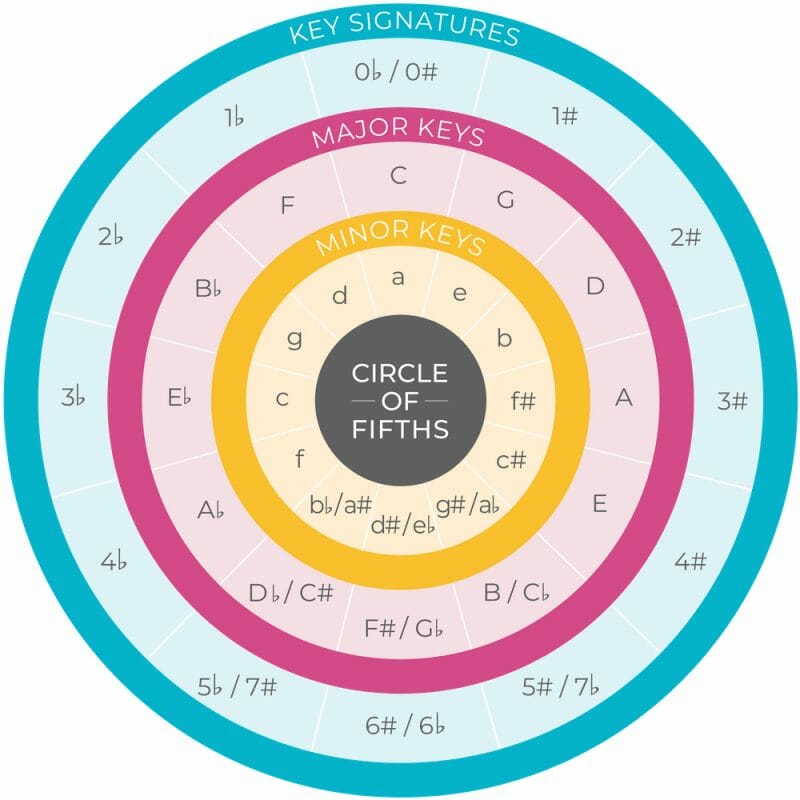Have you ever wondered why the melody and chord progression you use in your songs sound “right”? It’s largely because they come from the same group of related notes called a key.
Each key has its own individual key signature. But there are 24 possible keys – 12 major and 12 minor.
I know. It’s a lot.
But today we’re going to be covering your own personal key signature cheat sheet: The circle of fifths.
It’s a great way to visualize all the keys (and how they all fit together).
It makes navigation between what chords you can use quick as a wink. And that makes you a more valuable and, possibly, more innovative songwriter.
So let’s learn exactly how the circle of fifths works and how you can use it in your own playing.
If you’re like most composers and writers, you’re probably producing your own music as well. We put together a brief training that covers a totally new approach to music production. Until now, everyone has been teaching production totally backward. Just click below to watch. Get industry-quality mixes every time (steal this framework)
But if you just want to learn about the Circle of Fifths specifically, keep reading.
How does the circle of fifths work?
The 12 notes of the musical alphabet are as follows:
A | B♭ | B | C | D♭ | D | E♭ | E | F | G♭ | G | A♭
The circle of fifths displays each of these notes in a sequence of perfect fifths, starting at the midnight position.
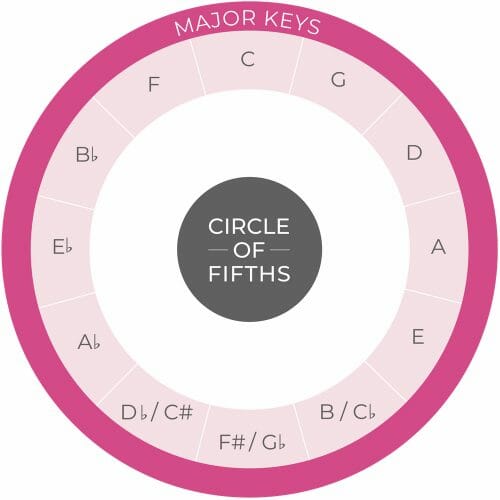
As you move clockwise through the 12 notes, you jump a fifth. C to G, G to D, D to A, and so on. Eventually, you’ll end up back at C.
C → G → D → A → E → B → G♭ → D♭ → A♭ → E♭ → B♭ → F → C
Key Signatures in the Circle of Fifths
Now, the notes on the circle aren’t just notes. They also represent keys in key signature order – sharps (♯) to the right and flats (♭) to the left.
So the letter C also stands for the key of C major (the only major key with no sharps or flats).
To the immediate right is the key of G major, with one sharp in its key signature.
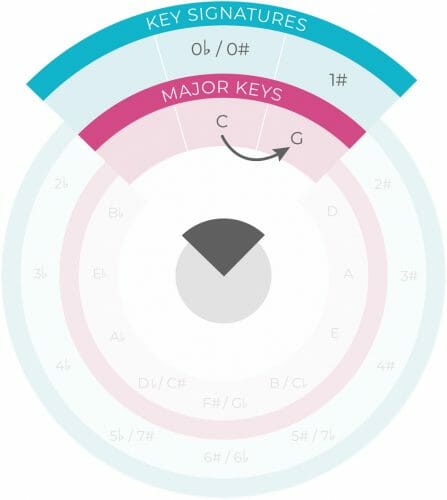
To the immediate left of C is the key of F major, with one flat in its key signature.

As you move further around the circle clockwise, you add a sharp at a time to the key signature. You hit the maximum number of sharps, seven, in C♯ major.
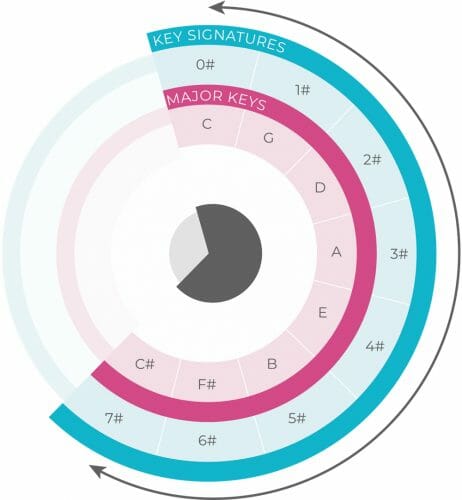
If you move around the circle counterclockwise, each key adds a flat to its key signature until you have a full house of seven flats, C♭ major.

A Circle Within a Circle
You can see that the circle of fifths is actually two circles: the major outer ring and a minor inner ring.
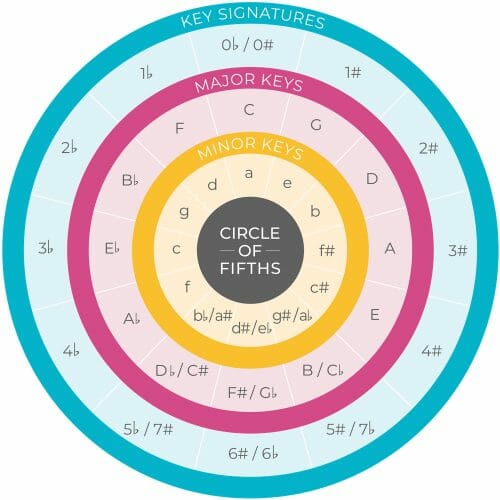
Every major key has a relative minor. They share the exact same notes, but the minor scale starts three semitones back from the major key’s root note.
C major has a relative: A minor. Same notes, different starting point.
C major: C | D | E | F | G | A | B | C
A minor: a | b | c | d | e | f | g | a
The minors are adjacent to their relative majors but on the inside of the circle of fifths.
The notes used in the circle are the same, but they’ve been tagged with a small ‘m,’ meaning they’re minor chords.
And that’s all the parts of the circle of fifths! But how do you actually use it?
So how can I use the circle of fifths?
There are tons of uses of this amazing tool. Here’s a few tips.
Tip #1: Use it as a quick reference guide to key signatures.
You’re able to see the number of sharps and flats in any key signature instantly. This is great for songwriting or improvising with a band.
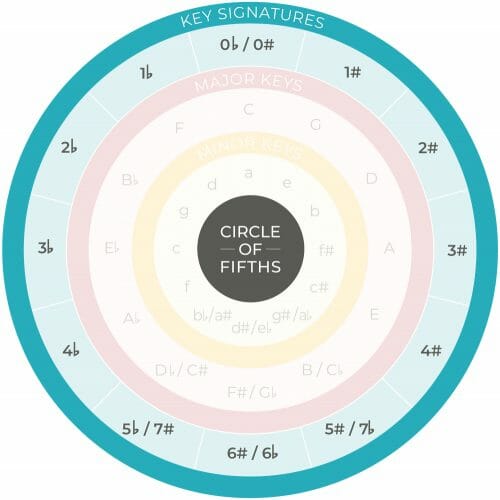
Tip #2: Find any key’s relative major or minor at a glance.
Say you want to create contrast in your verse compared to your chorus, which has a C → F → G → C progression. Use the relative minor (on the inside ring) to find your quickest options: Am → Dm → Em → Am.
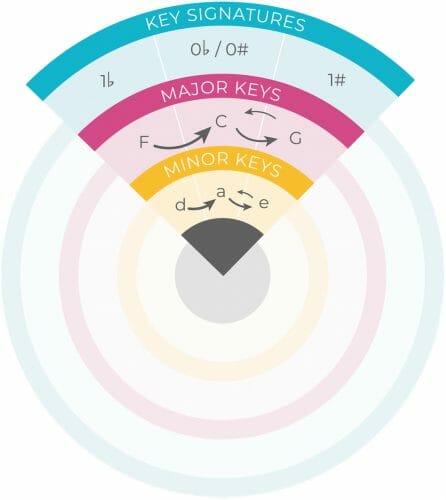
Tip #3: Find the closely related keys.
These are close to one another on the circle. This can really help if you want to modulate (or change key) in your song. Keys adjacent to each other share six of the same notes. For example, D major shares six notes with its next-door neighbor, G major:
D major: D | E | F♯ | G | A | B | C♯ | D
G major: G | A | B | C | D | E | F♯ | G
The only note difference is C/C♯.

Tip #4: Find the enharmonic keys (same sounds, different names).
These are all found at the bottom of the circle. The three adjacent pairs of major keys and their relative minor keys are:
major keys: B / C♭ – G♭ / F♯ – D♭ / C♯
minor keys: B♭m / A♯m – E♭m / D♯m – A♭m / G♯m
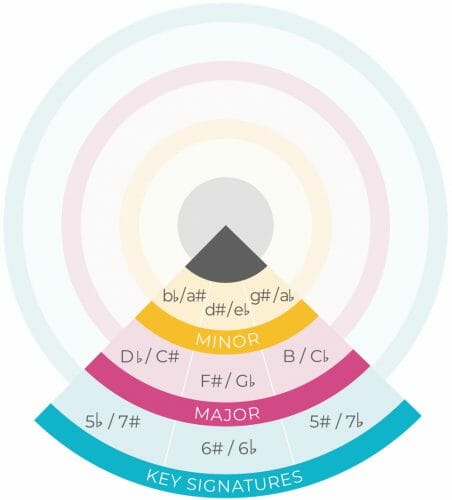
Tip #5: Find your key’s chords instantly.
These chords are known as diatonic, which means chords built from the scale of the song’s key.
For example, let’s look at C major:
C major’s notes: C | D | E | F | G | A | B | C
Now, let’s make chords from those notes. All of these chords are diatonic:
C major’s chords: C | Dm | Em | F | G | Am | Bdim | C
Look at where C major is on the circle of fifths. To the immediate left is F major, and to the immediate right is G major.
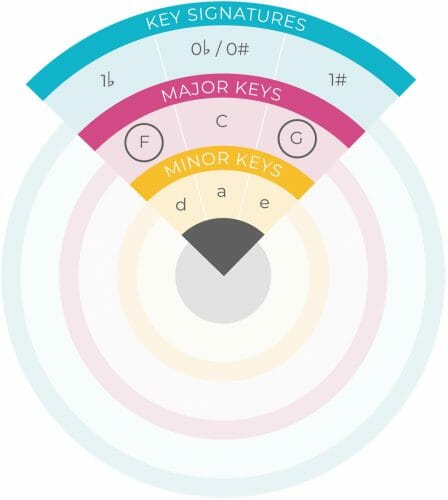
Directly below is its relative, A minor, while diagonal left is D minor and diagonal right is E minor. One more step over is B – admittedly minor, but switch it in your head for Bdim.
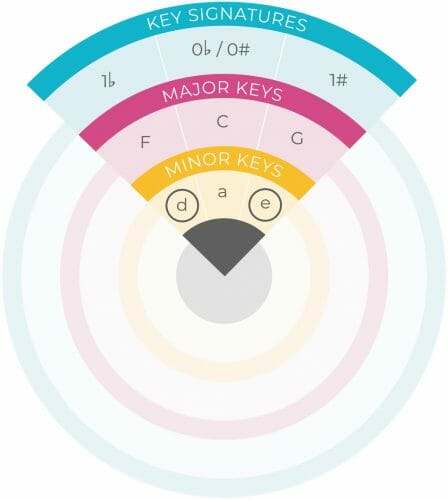
So all of the diatonic chords are directly next to your key. This pattern on the circle works whatever key you’re in!
Tip #6: Find weird chords to experiment with.
The opposite of Tip #5 also holds. If you want to push the boat out and go somewhere different harmonically, just cross the circle.
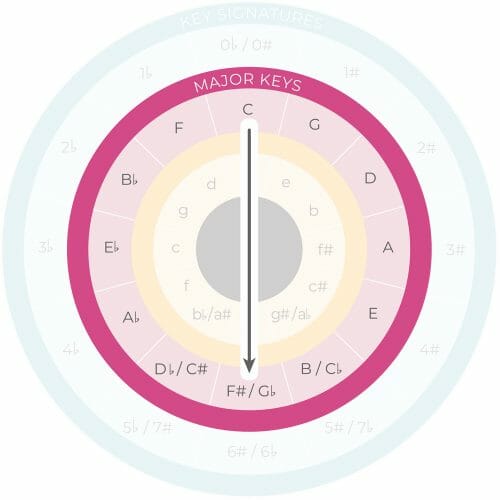
The further apart two keys are, the less related they’ll be. Plus, their scales will share fewer notes. And if you want to find a tritone, it’s always 180 degrees across the circle for any particular key or note, e.g., C to F♯.
Tip #7: Use it for the most famous chord progression.
The circle of fifths highlights the most important chord progression in Western music harmony: V → I. In fact, you could start at any point in the circle and create a song I → V → I around the entire circle. C → G → D → A → E and so on in a never-ending dominant-tonic motion.
If you’re stuck in your songwriting, go grab your circle of fifths and give its chord progression a go.
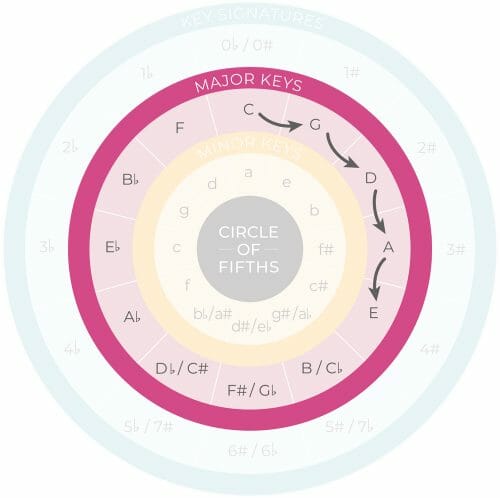
Conclusion: Circle of Fifths
The circle of fifths holds much more information about music relationships within it. You can happily geek out here for more.
But as a quick reference guide to some important music theory you can apply right now, it’s worth its weight in gold!
If you want to dig deeper into music production and learn what it actually takes to make mixes that sound pro… And you’re an intermediate or advanced producer… Be sure to check out the free masterclass: Enjoy!Next Steps

